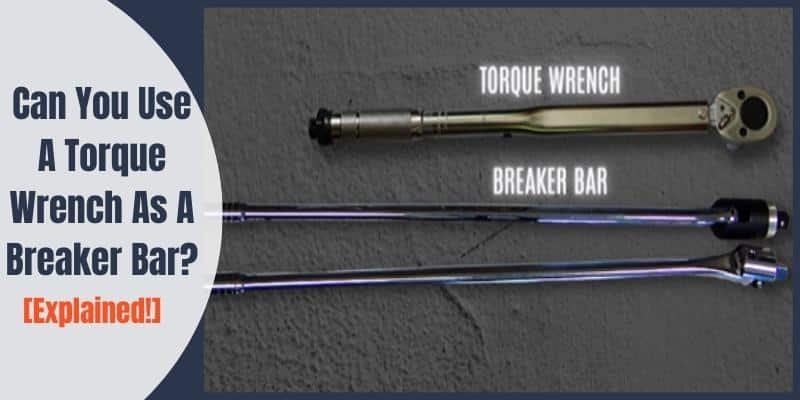Disclosure: This post contains affiliate links and I will be compensated if you make a purchase after clicking through my links. Learn More
Although both tools deal with nuts and bolts, a torque wrench and a breaker bar are designed differently for different purposes. Mechanics use torque wrenches for tightening the bolts, while they resort to a breaker bar for the complete opposite; and they’re particularly built to provide enough torque for these distinctive tasks.
Since both tools are intended for nuts and bolts, can you use a torque wrench as a breaker bar? Although this might not seem like much, to use a tightening tool for something reverse; from our experience and observation, we’d strongly recommend you not to do it.
DON’T DO IT. You cannot use a torque wrench as a breaker bar. Let us explain why.

How Do The Tools Work?
To know why you can’t use a torque wrench as a breaker bar you have to understand the mechanism of a torque wrench and breaker bar first.
How Does A Torque Wrench Work?
Since a specific torque is required to tighten the nuts and bolts on car wheels or heavy machinery, torque wrench was conceptualized to do that with less effort.
The torque is measured in lb/ft (foot-pound) or Nm (newton-meter) which the user has to set up on the measurement scale prior to using the tool for the desired application.
The user then has to keep twisting the handle until it reaches the proper torque level. Then it notifies to stop putting further pressure on the fasteners so that damaging the threads can be avoided.
This is how a torque wrench is used, to restore vehicle fasteners at their right level of torque so they don’t become loose when operational.
How Does A Breaker Bar Work?
Breaker bars are designed to be used like a socket wrench, but with the capacity to handle heavier pressure. While dealing with stubborn automotive nuts, socket wrenches fall short to provide enough leverage to loosen them.
This is where the breaker bar becomes necessary. Its structure allows the bar to bring out the nuts without breaking or stripping off their threads. That’s why breaker bar is sometimes referred to as a power bar.
It looks a lot like a socket wrench, but longer for a large amount of torque.
The socket is placed onto the nuts and bolts. Then the handle is twisted from a distance with maximum pressure; as the distance of the handle grows, the pressure increases. With excessive leverage, the nut will come loose in no time.
Torque Wrench Vs Breaker Bar: How Different Are They?
The only thing that is similar about breaker bars and torque wrenches is that both of them rely on torque leverage to do the job, and you should keep both around while handling lug nuts or similar parts. But if we were to measure the differences, it would go as follows:
Functions
We already mentioned this above. The breaker bar is designed to loosen stubborn nuts, while the torque wrench is designed to tighten them.
Leverage
Both tools are designed to deliver the necessary torque to tighten or loosen nuts and bolts. However, while 250 to 300 lb/ft of torque is enough for a torque wrench to restore tightness to most of the fasteners, breaker bars are often used to apply thousands of lb/ft of torque to make them come off.
Precision
A torque wrench’s performance depends largely on precision. There’s a unit scale on the tool that measures the level of torque applied and notifies when reached the required level. So one can easily know the amount of torque they’re applying while at work so that it doesn’t exceed the limit.
Breaker bar doesn’t have any limitation of that sort. You can put as much pressure as you want on its body and the bar will handle it. It comprises a socket and the handle, nothing to measure or limit the amount of torque.
Types
Torque wrench comes in several types and sizes depending on the fastening requirements. There’s the electric one that makes a beep sound, and another one that silently gives a reading, and then there’s the analog “click” torque wrench. And the sockets could range from ½”, ¼” to ¾”, ⅜”. Breaker bars don’t have these many distinctive variations. Rather it varies in bar length only.
Strength
In terms of strength, breaker bars are far superior to torque wrenches. They are rigid and made of strong metal. To strip or loosen a frozen nut, a massive amount of pressure is required, and so the bar is built as sturdily as possible. That is the reason they withstand even when 2000 lb/ft of pressure is applied.
Torque wrenches in comparison are much more fragile, if you push the handle beyond its torque limit, it may break. The stainless steel body is a lot less sturdy than that of the breaker bar.
Price
Because of the delicate build and advanced torque measurement mechanism, torque wrenches tend to be pricier than a breaker bar that’s just a solid metal wrench.
So, Can You Use A Torque Wrench As A Breaker Bar?
You already know the answer. No.
A torque wrench can never replace a breaker bar. It’s not built that way. The steel is too frail to handle the pressure required for loosening frozen nuts. If more pressure is applied to the wrench than its capacity, it will lose its calibration,
Still, if you try loosening, be ready to be left with a damaged torque wrench that’s no good for further use.
Wrapping Up
We hope after reading the blog post you’re clear about how the torque wrench works and why it’s not a viable option to use it as a breaker bar. Interestingly enough, the breaker bar’s mechanism does make it capable of fastening nuts. Still not recommended, because there’s a good possibility of the pressure damaging the thread.
